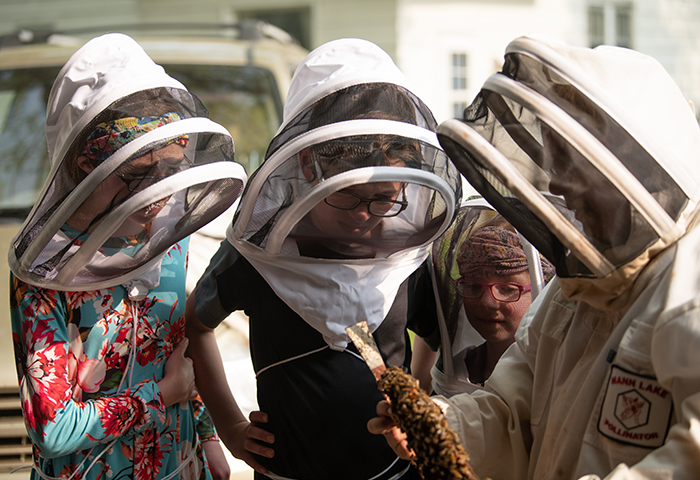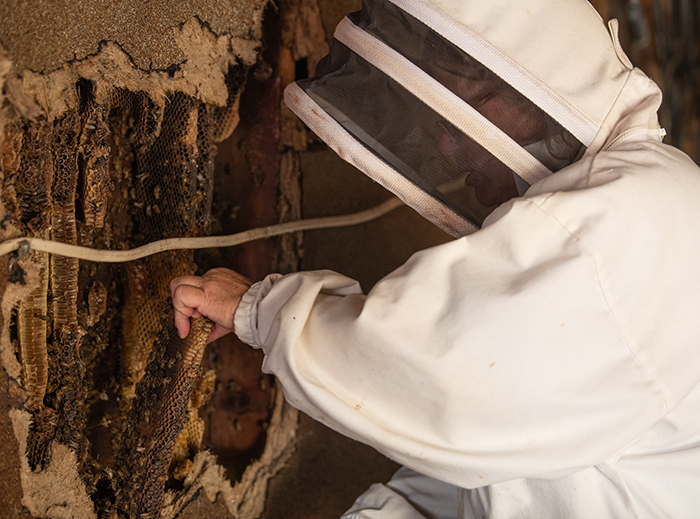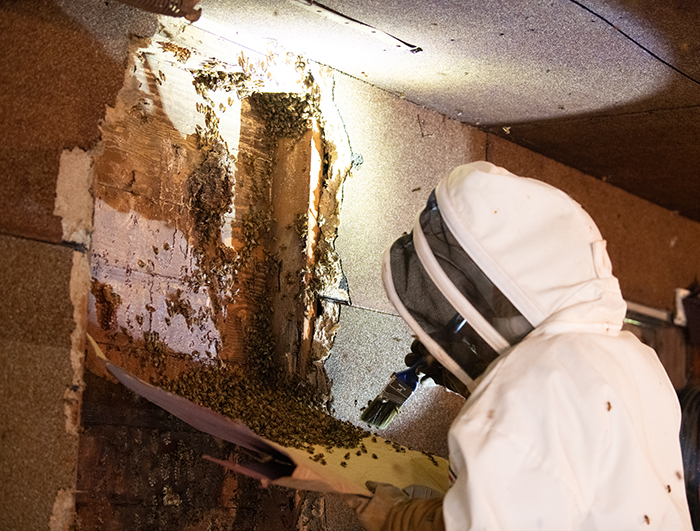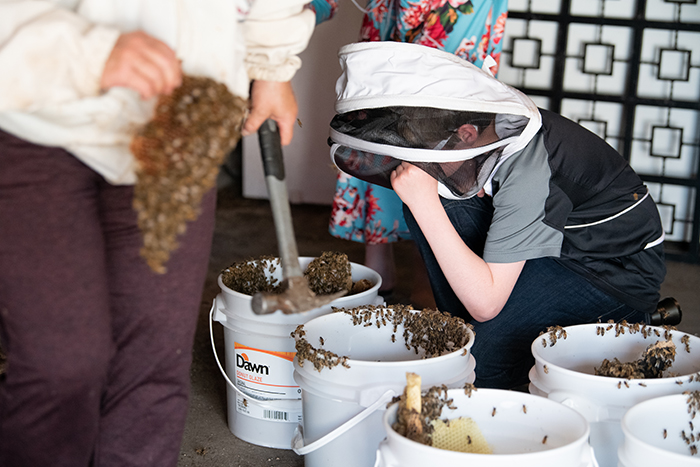A ‘buzzing’ good learning experience
News | Published on October 17, 2023 at 4:22pm EDT | Author: henningmaster
0Approximately 20,000 honey bees find a home in rural Henning

By Chad Koenen
Publisher

Joy Greenwaldt couldn’t escape a loud buzzing sound coming from outside her family’s home in rural Henning earlier this year. The cause of that buzzing sound was something the Jason and Joy Greenwaldt family will never forget. ¶ As Joy opened the door to their home she discovered what she thought were hundreds of bees swarming around their yard. It turns out there were approximately 25,000 honey bees that found a nice warm home in a detached garage at the family home. ¶ “I could hear this loud buzzing sound and I looked and I could just see all of this motion,” said Joy Greenwaldt. “When I went out there were thousands and thousands of bees.” ¶ Unsure of what the next steps would be, Greenwaldt reached out to several hobby beekeepers in the area to find out how she should move or get rid of the bees. After hearing her description of what was happening over the phone, hobby beekeeper Elizabeth William from Bertha asked Greenwaldt to send her a video of all of the bees so she knew what she was getting herself into. What she discovered was a far bigger bee colony than originally anticipated.

“She said I have some bees that swarmed into my yard and she said I think there are some 300 bees. She sent me a video and I said there are probably 10,000 there,” said William. “I would guess those bees would have been in the garage for a year and maybe longer.”
Ironically, perhaps, this wasn’t the first time that Greenwaldt saw and heard thousands of bees swarming around her house near Henning.
“A few years ago I saw thousands of them for like two days and then they were gone,” said Greenwaldt.
That time around the bees were mainly in the family’s yard, but just as quickly as they arrived they left and found a new home. Those bees may have helped to start the new hive in the Greenwaldt detached garage near their home.

“(William) is thinking when we saw them a few years ago and saw them in our grass that those are the ones that got kicked out (of another hive) and moved into our garage,” said Greenwaldt.
Not knowing what to do with the black swarm of bees flying through the sky, Greenwaldt basically had two options—buy a pallet worth of Raid and try to kill every last one of the flying insects, or find a beekeeper to save the bees. Not wanting to get stung hundreds of times by angry bees and hoping to find a safe home for the insects that didn’t include setting up an entertainment area in her front yard, Greenwaldt opted for the latter option.
As it turns out, finding a beekeeper to come and pick up the bees was a little bit more difficult than originally thought. Since the bees typically aren’t seen until they are getting ready to leave a hive, or they are out on their way to find another home, many beekeepers turned down Greenwaldt’s proposition to come and get the bees at her home since they figured the bees would be gone by the time they got to Henning. Making such a trip to Henning from an hour away can be costly and would not yield the kind of find that would make a trip to town worth their while.
“Everybody would like to save the bees, but it is a lot of work. I made three trips to the Greenwaldts,” said William.
While not the case for the Greenwaldts, who are planning to take the garage down in the near future as part of a remodeling project, the bees can set up a hive in a spot that is difficult to extract them. As a result, in certain instances bees cannot be removed safely without an expansive remodeling project. William did have to remove a wall in the garage to get the bees out of the garage.
“A lot of times I can’t get them because they are not accessible,” said William. “They get in-between some siding and there is no way to get them out and it is a big construction job to get inside there to get the bees.”
After Greenwaldt implored William to take a look at her nest and to save her bees, rather than just kill them, William made the trek from the Bertha area and came to the farm. Upon further investigation the bees had completely filled an entire section of the Greenwaldt’s garage near their home, from 2×4 to 2×4 and floor to ceiling. There was a nest and bees as far as the eye could see, and fortunately for both the beekeeper and family, the bees were honey bees capable of generating quite a large amount of honey for the masses.
What they discovered was the bees set up a nest from the floor to the ceiling in one section of the Greenwaldts garage. Had there been a hole in the wood or for wiring inside the wall, the bees likely would have continued to the next set of 2×4’s in the garage where the nest would have grown once again. Fortunately the old garage didn’t have any holes in the wood, which prevented further expansion of the nest.
Greenwaldt said her understanding was the bees she saw outside this spring were likely getting kicked out of the colony. When there are too many bees in too close of quarters some of them get kicked out and are forced to find a new home. That was likely how the bees ended up at the Greenwaldt farm north of Henning in the first place as they were looking for a new home when they discovered a nice warm place to set up shop in the Greenwaldt garage.
“What happens is they run out of room so they swarm,” said William. “They could have been in there for a long time and no one from the family would have noticed.”
When it came time to extract the bees from the garage, Greenwaldt’s three children were able to lend a helping hand. They helped to round up the bees and packaged them up for their new home. Working in the family’s favor was the fact the bees were honey bees, which tend to be a bit nicer than a conventional wasp or hornet.
“They thought it was really cool and they liked looking for the queen bee,” said Greenwaldt.
Though she is not 100 percent sure how many bees she got from the Greenwaldt farm, William estimates the total is about 25,000 bees. Ironically, perhaps, she has yet to find the queen bee. Without the queen bee the bees in general will not survive, but William said she has seen signs of the queen bee in the hive, just not the actual bee itself.
“I still to this day have never found the queen, but they are still here,” she said. “Without the queen the bees would have left and not stuck around.”
The bees that once lived at the Greenwaldt farm have now been mostly moved to the Bertha area where they remain today. Though the bee colony, which was actually producing honey when they lived near Henning, was a bit unique in its overall size, William said people who notice large swaths of bees can find a beekeeper association in their area online and ask someone to come out to take a look at the hive.

